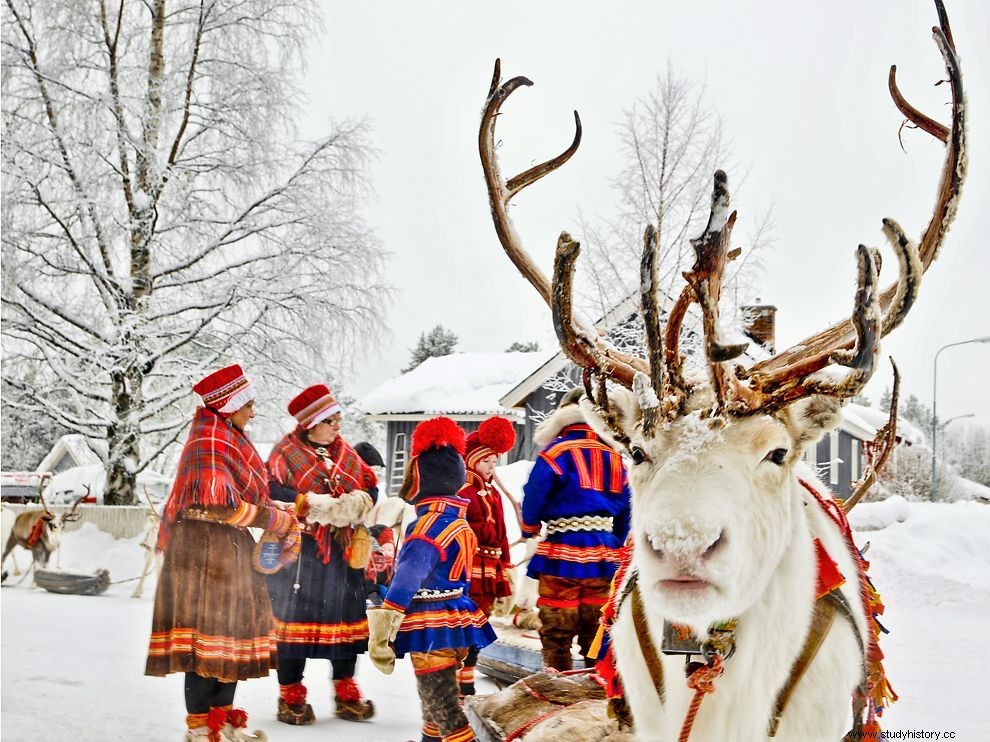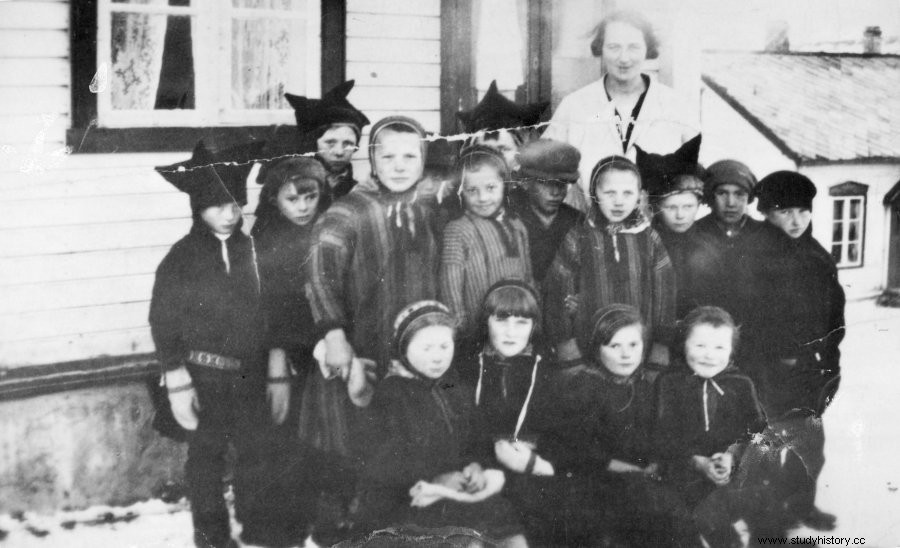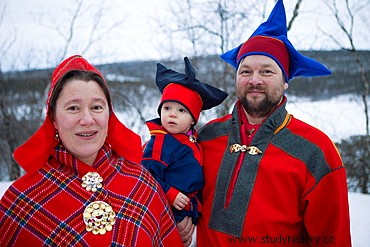
Who are the Sami? What's their story?
The Sami are the oldest indigenous ethnic group in Europe, spread over areas in northern Norway, Sweden, Finland and Russia. They are descendants of nomadic peoples who had inhabited Northern Scandinavia for thousands of years. Today, the Sami population varies from around 80,000 100,000 to XNUMX XNUMX, most of whom live in Norway. The Sami have traditionally built their livelihood through fishing, hunting and reindeer husbandry throughout the Arctic. They are best known for their close relationship with reindeer, an animal that still has significance in culture. The Sami have several other unique cultural traditions, such as 'gakti', traditional Sami clothing and other forms of crafts.
The earliest written records describing the Sami date back to the works of Cornelius Tacitus (56 AD-120 AD), a Roman historian and politician. In his ethnographic work Germany, Tacitus describes an encounter with a group of semi-nomadic reindeer hunters. Later, in his Langobard's story, The historian Paul the Deacon observes a similar group of reindeer herders who 'pursue wild animals very skillfully with a piece of wood bent like a bow'. The first mention of the term 'lappir', or 'lapps' to describe the Sami, dates back to the twelfth century, with the Danish historian Saxo Grammaticus.
Although much of this historical evidence is still sparse and somewhat inconsistent, it is believed that the first contact between the Sami and Norse missionaries (ancestors of dominant ethnic groups in our time) Norway, Sweden and Finland) began around the XNUMX century, when Ottar of the Norwegian Vikings met the Sami on a journey to what is now called the Kola Peninsula. Early relations between Norse missionaries and Sami consisted mainly of trade and exploitation; in exchange for furs and other goods, the Sami could acquire grain and iron tools.
In the nineteenth century, however, it was seen that the Sami were racially inferior to other Scandinavian ethnic groups (this is partly due to the rise of social Darwinism), which inspired Norwegian efforts to lift the Sami from their conditions and assimilate them through education. The introduction of these guidelines led to a period known as 'Norwegianisation', which lasted until the end of the twentieth century.
Sami language:
The Sami speak a total of ten separate but related languages (six of which have written standards) throughout Scandinavia, three of which are in active use in northern Norway. These languages are very different from other Indo-European languages; rather, the Sami language is instead a member of the Uralic or Fenno-Ugrian linguistic group, spoken from Central Sweden and central southern Norway to the tip of the Kola Peninsula. There are no deep linguistic boundaries between Sami dialects; However, Sami from different areas may not always be able to communicate with each other due to linguistic differences.
The use of the Sami language plays a role in everyday life, and is based on both tradition and cultural continuation. However, it is estimated that only 25,000 35,000–1992 XNUMX Sami speak their mother tongue today, a small percentage of the entire population; The slow death of the language is mainly an effect of the Norwegianisation policy in the nineteenth and twentieth centuries, where many Sami children were forced to learn the Norwegian language and ignore their mother tongue. In XNUMX, the Sami Language Act was passed in Finland, which gave the Sami the right to 'use the Sami language before the authorities, orally and in writing, and receive answers in the same language'; this was done in an attempt to make up for previous oppressive policies, and to raise the Sami language to Finnish status in Scandinavian society.
Although the Sami have gained more cultural autonomy in recent decades, language rights are still an urgent topic for Sami representatives today - limited resources have been made available to those who want to learn the language, making it more difficult to use the Sami language in business and social affairs. settings.
Sami religion:

In addition to their language, the Sami religion stands out in relation to Indo-European belief systems. The Sami religion combines shamanic beliefs with components from both animism and polytheism. Like other pagan religions, the Sami celebrate a cycle of death, life, and rebirth, and their spiritual beliefs believe that all parts of the natural world contain a spirit or life force. Among their many polytheistic views, the spirit of the father, mother, son and daughter is considered to be the most important; in the Sami language these are referred to as 'Radienecca', 'Radienacce', 'Radienkiedde' and 'Radienneida'.
The shamans, or 'noiade' in Sami culture, are highly respected and determined figures among practitioners of the Sami faith. They act both as protectors and healers in Sami communities, as well as media between the world of the living and the dead. Shamanic rituals usually involve practice in joiking, another important Sami tradition, which combines a rhythmic song with the accompaniment of a sacred drum. In these rituals, the drum itself is seen as a tool used to represent connections to the breathing area. Sami religious practice has received more global attention recently, and was even an influence on the design of the animated function from 2013, Frozen . After the production of the film, Disney Studios signed an agreement with Sami advisory groups to ensure that their beliefs and traditions were presented in a respectful manner.
Joiken:
The yoik can be seen as representative of the entire Sami culture, in itself. Simply defined, the yoik as a form of song, which uses unique rhythms and vocalizations to express everything within the Yoiker conception at all times. A yoik can not be imagined in the way we would normally consider a song, at least for many western audiences. A yoik is usually not accompanied by musical instruments, and is not seen as a performance. The structure of a yoik is non-linear; it does not follow western musical traditions, in the sense of having a concise beginning or end. The yoik rather follows the traditional Sami saying of 'no beginning, no end'.
In addition, joik is not a song, in the sense that it is not what it is about something; rather a joik is something. Because it can represent everything within the Yoiker conception, emotions, animals and even other people can be 'yoiked'. As such, it is practiced in many situations as part of everyday life, and many Sami follow their daily activities with a yoik. In terms of technique, the yoik uses almost the entire spectrum of human vocal potential. It is a skill that emphasizes the vocal cords, and therefore requires careful breathing control. Joiking as a musical genre can be divided into three different dialects, which roughly correspond to dialectical areas of the Sami language:the northern form is known as' luohti ', the southern as' vuolle ', and the eastern as' leu'dd '.
Reindeer herding and nomadism:
Reindeer have remained an important component of Sami culture, spirituality and economy for centuries. Before the first contact with Norse missionaries, the Sami were mainly nomadic and herded reindeer in small numbers; at this time, sami nomads would follow reindeer on foot as they searched for ideal grazing areas over hundreds of miles of arctic terrain.
Although nomadism has practically disappeared today, reindeer still play an important role in Sami everyday life, and are usually kept in larger herds. Reindeer provide adapted Sami families with meat and milk, skins for clothes and shoes, bones for tools and weapons, and even tendons for sewing. In fact, there are over 1,000 words across Sami dialects dedicated to describing reindeer. Contemporary Sami shepherds refer to their world as 'boazovazzi', which can be translated as 'reineer walker'.
Norwegianisation and its lasting effects:

Like many other indigenous peoples around the world, the Sami have been subjected to several forms of ethnic, religious and cultural discrimination by dominant ethnic groups. The policy of Norwegianisation in the nineteenth and twentieth centuries is a good example of this. Around 1850 and 1950, these policies of assimilation or snoring emerged out of a belief that the Sami posed a threat to dominant ethnic groups, and that they had to be 'civilized'. In 1851, years after the Norwegian state got its constitution, the parliament introduced a policy known as 'Finnefondet', or 'The Lapp Fund', a section of the national budget reserved for change in language and culture. Finnefonden's guidelines promoted teaching of Norwegian in intermediate districts to ensure "enlightenment" of the Sami people, especially Sami children who go to school. It was through these guidelines that the Sami mother tongue began to slowly die.
From this point on, the measures were tightened. In 1880, all Sami children were required to learn to speak, read and write Norwegian, and even be punished if they spoke the Sami language in the wrong environment. Funding for Norwegianisation policies tightened even more until the early 1960s, especially after the First World War due to greater fears of invasion from the east and changes in the Scandinavian borders. These measures are assumed to have taken place during and outside school hours until the end of the XNUMX number.
Although the Sami now have greater political autonomy and continue to advocate for language and cultural rights, the lasting effects of the Norwegianisation policy have led to permanent damage to the Sami language's survival and lack of mother tongue which is mother tongue today.
The Sami today:

The Sami have experienced something of a cultural renaissance in recent years. In the 21st century, Sami culture is being introduced to the world in innovative ways; knowledge and interest in the Sami has grown rapidly with the emergence of social media and digital publishing. The Sami now have their own national theater, as well as broadcast media that use their language. The Sami Parliament was also opened in 1989, which provides visitors with guided tours and introductions to Sami culture.
Unfortunately, there are ongoing and new threats to the Sami way of life that have not diminished with this growing cultural interest. In Norway, large wind farms and property developments are affecting Sami land used for reindeer grazing, a loss that the Sami see as the greatest threat to livelihoods and culture. Several Sami settlements in the upper part of Finland are also sought after by European companies.
In particular, railway promoters have advocated for the development of a railway through Finnish Lapland to the EU's Arctic port in Norway, as well as for further utilization of the region's natural resources. It is estimated that the region contains 5-13% of the world's untapped oil, and 20-30% of the world's untapped gas; In fact, comparisons have been made between modern Lapland and the gold rush in California at the end of the nineteenth century. These lands, which have been occupied by the Sami for centuries, are often seen as Europe's last great wilderness, or 'Europe's lungs'.
Both the Sami local population and climate researchers are in opposition to the projects, as they will further disconnect the inhabitants and put the country's ecosystem environments in danger, which is crucial in the ongoing fight against ongoing climate change. The democratically elected members of the Sami Parliament are in an ongoing struggle to defend Sami land and cultural rights against the threats from these conflicts.
It is clear that the Sami people and their cultural landscape play a significant role in several global issues, including an ongoing fight against climate change that may ultimately disconnect foreign groups, but others around the world. Although there are powerful political and diplomatic factors to consider in light of these issues, an examination of the rich cultural history of the Sami and their relationship to the natural world exemplifies the global benefits, and even conflict solutions, that can be found through the strengthening of the voices and experiences of indigenous peoples.

